In gas-assisted injection molding (GAIM) process, “gas fingering behaviors†are one of the most common issues. This happens when gas bubbles penetrate unevenly into the core of the plastic parts and form finger-shape branches out of the desired gas channel. Severe fingerings can lead to significant reductions in part stiffness [i]. According to the investigation of GAIM, gas fingering behaviors are mainly caused by secondary gas penetration [ii]. Short shot method was applied in GAIM at early stages to hollow the product using assistant gas to save materials and reduce product weight. When GAIM ribs are used to enhance the strength of a thin plate, the ribs will become gas channels and will be hollowed by auxiliary gas. If the ribbed plate geometry is not well-designed, the product strength will be significantly reduced because of improper hollowing [iii]. To address the warpage issue, “full shot gas-assisted injection molding†is often applied to compensate shrinkage and improve product quality. In this molding process, auxiliary gas enters the mold when the cavity is full of melt. Thus, the gas penetration way can only be secondary penetration, so the hollowed area is relatively small. Meanwhile because of the gas hollowing, the residual stress of the hollowed area can be reduced, and sink marks can also be reduced[iv]. However, the secondary penetration behaviors in full shot gas-assisted injection molding will lead to complicated gas fingering behaviors. This case features the simulation of a complicated product geometry using full shot injection molding. The part in this case is a printer cover (Fig. 1). It requires good flatness and strict deformation specification, or the paper cannot be sent successfully. In this case, auxiliary gas will hollow the structural ribs to avoid sink marks and enhance the mechanical properties of the area after the mold is filled with melt. The material used in this experiment is amorphous transparent Acrylonitrile Butadiene Styrene (ABS), which facilitates the gas penetration comparison of simulation and experimental results as well as the evaluation of secondary penetration prediction accuracy. The simulation tool used in this case is Moldex3D, and the material parameters are Moldex3D default values. In this full shot gas- assisted injection molding process, gas enters the cavity when the melt starting shrinking and release space for the gas penetration. However, the melt has already occupied most of the flow space, so the gas will be released from the gas channels to other area where gas channels are not required. Therefore, obvious gas fingering behaviors will occur. Severe fingering behaviors will significantly reduce product stiffness, impact strength and stability. Thus, if we can find the areas that fingering behaviors tend to occur, we will be able to decide proper entrance of the gas needles. Because of the double-gate runner system design in this case, the melt front will flow from the gates to the thin area, and the flow path will be radial. As shown in Fig. 2 and Fig. 3, the melt front simulation and experimental results are very consistent at both 2 seconds and 2.84 seconds. As shown in the comparison of the experiment and simulation results (Fig. 4), after the cavity is filled, there will be 3 gas inlet points, where 3 fingering behavior areas (hollowing branches) will occur. Branch #2 occurs at Gas needle #2 in the center of the bottom; Branch #1 and #3 occur at Gas needle #1 and #3 at the left and right sides. Gas needle #2 is the closest to the melt entrance, so the melt temperature here is the higher when the gas enters. Thus, the flow resistance is reduced, and the fingering behavior here is the most obvious. On the other side, the melt temperature at the rest of the gas needles is lower, and the gas fingering behaviors are less obvious. This can be observed in the iso-surface graph of the shrinkage rate (Fig. 5). The average shrinkage rate values are mainly at Gas needle #2. The fingering behavior area cannot be easily measured in the experiment. Therefore in order to quantify the size of the fingering behavior area, we define the shadow area of the fingering behaviors according to the study[v]as below: The secondary gas penetration behaviors in the simulation and experiment results are validated consistent. Thus, we know that Moldex3D Gas-Assisted Injection Molding Module can effectively predict the gas fingering behavior distribution, and help users improve product structure stability. [i] X. Lu, H.H. Chiang, L. Fong, J. Zhao and S. C. Chen, “Study of “gas fingering†behavior in gasâ€assisted [ii] K.Y. Lin and S.J. Liu, “The influence of processing parameters on fingering formation in fluid†[iii] R.D. Chien, S.C. Chen, M.C. Jeng and H.Y. Yang, “Mechanical properties of gas-assisted injection [iv] S.Y. Yang, C.T. Lin and J.H. Chang, “Secondary gas penetrations in ribs during fullâ€shot gasâ€assisted [v] S.J. Liu and S.P. Lin, “Factors affecting the formation of fingering in waterâ€assisted injectionâ€molded Extrusion Grade Tpee,Extrusion Grade Polyester Rubber,Extrusion Grade Tpee Material,Engineering Plastic Tepp Ningbo Neon Lion Technology Co., Ltd. , https://www.neonliontech.comSpecially thanks to Lite-On Technology Corporation for providing experimental data of gas penetration and fruitful discussions.                                                                                                  Â
Jim Hsu
 Fig. 1 The part geometry of a printer cover in this case
Fig. 1 The part geometry of a printer cover in this case
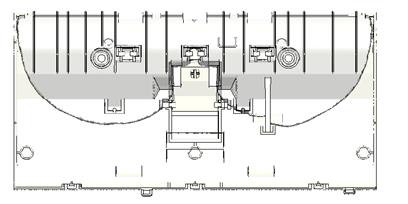 Fig. 2 The experimental (above) and simulation (bottom) results of the melt front at 2 seconds.
Fig. 2 The experimental (above) and simulation (bottom) results of the melt front at 2 seconds.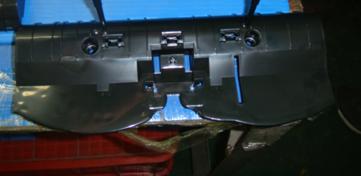
 Fig. 3 The experimental (above) and simulation (bottom) results of the melt front at 2.84 seconds.
Fig. 3 The experimental (above) and simulation (bottom) results of the melt front at 2.84 seconds.  (a)                                                  (b)
 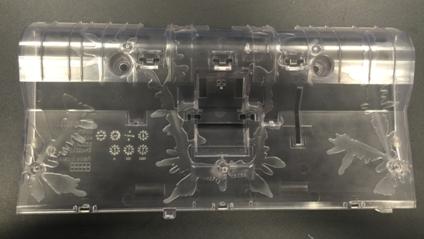
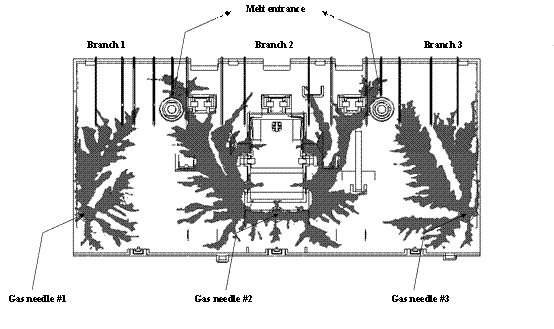 Â Â Â Â Â Â Â Â Â Â Â Â Â Â Â Fig. 4 The experimental (a) and simulation (b) results of the gas hollowing of the printer
               Fig. 4 The experimental (a) and simulation (b) results of the gas hollowing of the printer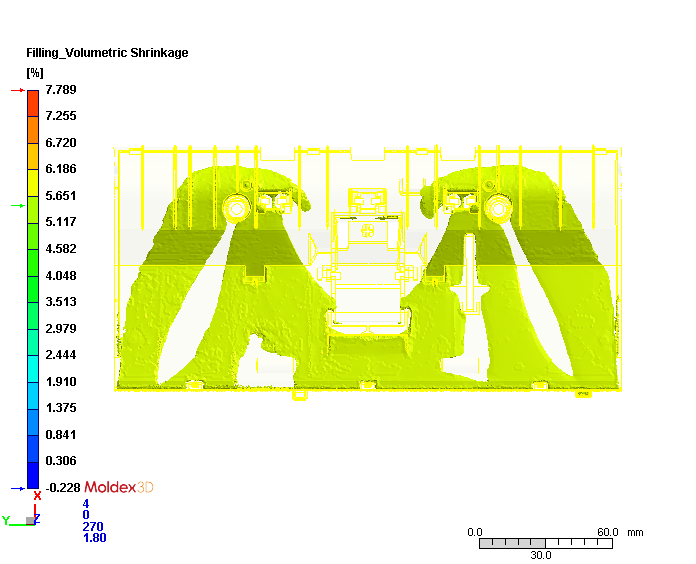 Fig. 5 The simulated iso-surface graph of the average shrinkage rate when the assistant gas enters
Fig. 5 The simulated iso-surface graph of the average shrinkage rate when the assistant gas enters
![]() Â is the total shadow area of the fingering behaviors from top view. Comparing the fingering behavior area in the experiment and simulation, we can find a consistent trend (Fig. 6).
 is the total shadow area of the fingering behaviors from top view. Comparing the fingering behavior area in the experiment and simulation, we can find a consistent trend (Fig. 6).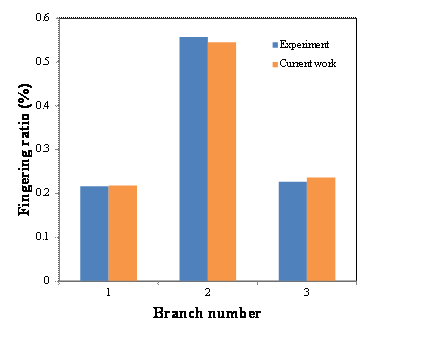 Fig. 6 The comparison of the fingering ratio in the experiment and simulation results
Fig. 6 The comparison of the fingering ratio in the experiment and simulation results
  injection moldingâ€, Polymer Engineering & Science, 39 (1) , 62-77, 1999
   assisted injectionâ€molded disksâ€, Polymer Engineering & Science, 49 (11), 2257-2263, 2009
   moulded PS, PP and Nylon partsâ€, Polymer, 40(11), 2949-2959, 1999
   injection moldingâ€, Advances in Polymer Technology, 22(3), 225-237, 2003
   thermoplastics”, Advances in Polymer Technology, 25(2), 98-108, 2006

Dr. Jim Hsu
Senior Director at the R&D Division of CoreTech System (Moldex3D)Jim Hsu has a doctoral degree of Department of Chemical Engineering, National Tsing Hua University. Currently, he is the Program Manager at the R&D Division of Moldex3D, focusing on solver and program specification customization development. His fields of research include the materials research of polymer rheology, computational fluid dynamics / CAE solver development, IC packaging process, fluid (gas, water) assisted injection molding, co-injection molding and resin transfer molding. Dr. Hsu has published around 20 technical papers and obtained several patents. He is also cooperating with many IC packaging manufacturers on development projects.
Predicting Gas Fingering Behaviors Using 3D GAIM Simulation Tool
1. It has superior processing performance than TPU: low shrinkage rate, shorter molding cycle, and good demolding performance
2. It has both: high mechanical strength and high hardness while maintaining high elasticity and high aging resistance.
3. Excellent bending performance
4. Low temperature resistance in -35-50℃ and high temperature resistance, its aging resistance at 150℃ is stronger than TPU, TPR/TPE
5. Low long-term compression deformation rate.